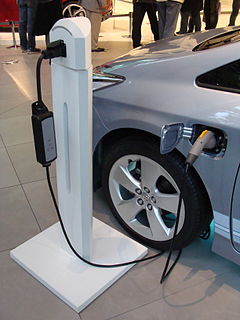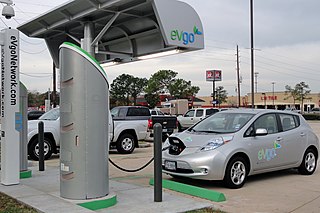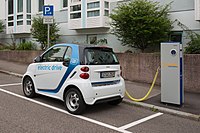Related Research Articles

As of March 2022, there were about 62,000 electric vehicles in New York, accounting for 0.6% of all vehicles in the state.

Electric car use by country varies worldwide, as the adoption of plug-in electric vehicles is affected by consumer demand, market prices, availability of charging infrastructure, and government policies, such as purchase incentives and long term regulatory signals.

Government incentives for plug-in electric vehicles have been established around the world to support policy-driven adoption of plug-in electric vehicles. These incentives mainly take the form of purchase rebates, tax exemptions and tax credits, and additional perks that range from access to bus lanes to waivers on fees. The amount of the financial incentives may depend on vehicle battery size or all-electric range. Often hybrid electric vehicles are included. Some countries extend the benefits to fuel cell vehicles, and electric vehicle conversions.

The stock of plug-in electric passenger cars in Canada in use totaled 141,060 units at the end of 2019, consisting of 78,680 all-electric cars and 62,380 plug-in hybrids. Sales totaled 50,960 units in 2019.

The adoption of electric vehicles in Hong Kong is actively supported by the Hong Kong government, which recognizes battery electric vehicles, plug-in hybrids, and conventional hybrid electric vehicles to be environmentally friendly and eligible for financial incentives. As of 31 October 2017, there were 11,039 electric vehicles in Hong Kong, up from less than 100 in 2010. At present, 73 EV models from eight countries have been approved by the Transport Department to be eligible for the incentives. These include 51 models for private cars and motorcycles and 22 models for public transport and commercial vehicles.
Electric vehicle policies in Australia include incentives such as electric vehicle subsidies, interest-free loans, registration exemptions, stamp duty exemptions, the luxury car tax exemption and discounted parking for both private and commercial purchases. The adoption of plug-in electric vehicles in Australia is driven mostly by state-based electric vehicle targets and monetary incentives to support the adoption and deployment of low- or zero-emission vehicles.

As of May 2022, there were about 129,000 electric vehicles registered in Texas.
As of August 2022, there were about 96,000 electric vehicles in Florida. As of January 2022, 3.5% of all new vehicles sold in the state were electric.
As of December 2021, there were about 5,000 electric vehicles in Vermont, accounting for less than 1% of all vehicles in the state. As of August 2021, 5.1% of new vehicle registrations in the state were electric.

As of November 2021, there were about 41,000 electric vehicles in Maryland.
As of December 2021, there were about 64,000 electric vehicles in New Jersey. As of 2022, 5% of all new vehicles sold in the state were electric.
As of July 2022, there were about 25,000 electric vehicles registered in Connecticut. About 25% of vehicles registered in the state between July and December 2021 were electric.
As of March 2021, there were about 4,000 electric vehicles in Delaware.
As of April 2022, there were about 4,200 electric vehicles registered in New Mexico. As of 2021, 1.7% of new vehicles sold in the state were electric.
As of 2022, there were about 80,000 electric vehicles in British Columbia. The province has the highest number of electric vehicles of any Canadian province or U.S. state. As of 2021, 13% of all new vehicles sold in the province were electric.
As of 2022, there were about 1,200 electric vehicles in Saskatchewan, accounting for about 0.1% of all vehicles in the province.
As of October 2021, there were about 67,000 electric vehicles in Ontario. As of 2021, about 3% of new vehicle registrations in Ontario were electric.
As of March 2022, there were about 76,000 fully electric vehicles and 57,000 plug-in hybrid vehicles in Quebec. As of 2021, about 6.8% of new vehicle registrations in Quebec were electric.
As of September 2022, there were about 2,600 electric vehicles in Nebraska, equivalent to 0.2% of all vehicles in the state.
As of 2020, about 0.45% of all new vehicle sales in West Virginia were electric.
References
- ↑ Cox, Aidan (October 12, 2022). "Fredericton spending $250K on electric vehicle chargers, but not all councillors on board". CBC News. Retrieved October 27, 2022.
- ↑ Brown, Silas (October 13, 2022). "Number of electric vehicles on N.B. roads doubles after incentive introduced". Global News. Retrieved October 27, 2022.
- ↑ "Electric vehicle incentive program announced". July 8, 2021. Retrieved May 16, 2022.
- ↑ Delattre, Simon (August 29, 2022). "Un premier concessionnaire de véhicules électriques dans le Grand Moncton". Acadie Nouvelle (in French). Retrieved October 27, 2022.
- ↑ Delattre, Simon (July 11, 2022). "De plus en plus de Néo-Brunswickois adoptent la voiture électrique". Acadie Nouvelle (in French). Retrieved October 27, 2022.
- ↑ Lothian, Robert (June 20, 2022). "New Saint John electric bus the first of its kind in North America". Global News. Retrieved October 27, 2022.

